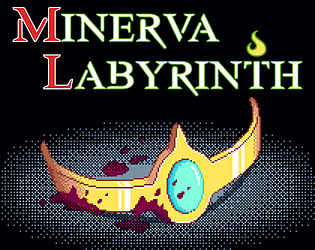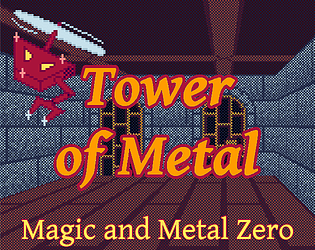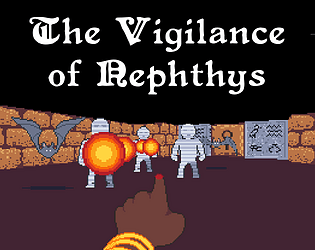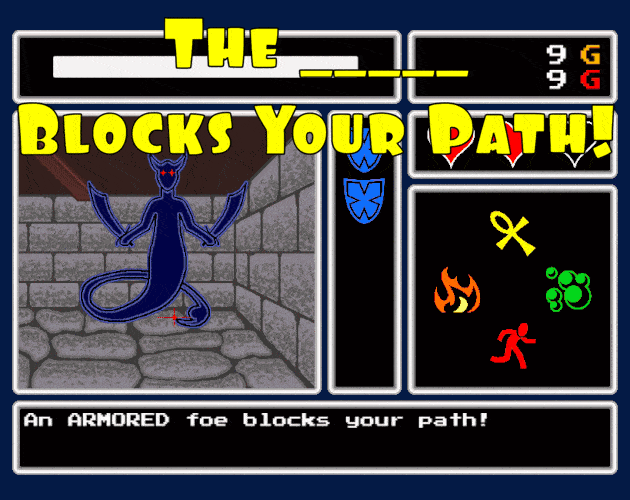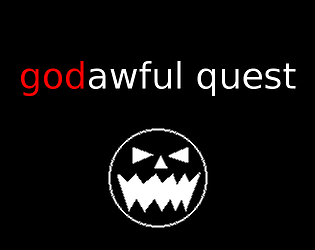Good progress!
Midnight Spire Games
Creator of
Recent community posts
As much as I love RPGs, no, it's not necessary or even beneficial for every game. For example, there are countless action and arcade games that have no permanent character progression (though many have temporary powerups). Consider classic games like Ninja Gaiden, Contra, Castlevania, Streets of Rage, or Super Ghouls n' Ghosts. Gameplay satisfaction in games like these primarily comes from building mastery and overcoming increasingly difficult challenges. Beating them is memorable and feels great. Of course some games in this style do have ability / stat progression (e.g. Megaman and especially the X series), but it isn't required.
Some recent AMD video drivers have been causing problems with Vulkan. If you have an AMD video card and the level geometry doesn't render (mostly black or blue field screen), try updating or rolling back your drivers, or playing in OpenGL mode. For me, this seems to be resolved with the latest drivers (25.11.1), but I will update if I encounter any further issues.
Screenshot of the issue:
https://imgur.com/a/3jIZGsh
More details here:
https://github.com/godotengine/godot/issues/109378
This is great! Clever puzzles with great sprite work and animation and an interesting story on top. I was a little confused at first and it took me a bit to get the hang of how the shadows work, but once I did it was a really cool mechanic with room for mastery. I wish there were more levels, but I did go back to get all of the achievements, both to uncover the lore and to test my skills with a better understanding of the game.
The basic style of the game reminds me a bit of Ronin, another action puzzle game, but of course the execution and mechanics here are totally different.
Sorry it took me a little while to check it out, it's been a busy year.
If needed, all of the above can be found in subdirectories in the following locations. If you experience a crash, freeze, scripting error, etc., please include any details from the log file. This will help me identify the issue.
WINDOWS: %AppData%\Midnight Spire Games\Minerva Labyrinth
LINUX: ~/.local/share/Midnight Spire Games/Minerva Labyrinth
Really cool mini crawl. I like the story and atmosphere, and the mechanic of having to choose to give up specific capabilities as you progress is interesting. Combat is nice and quick and I liked that I could attack with guns before enemies got close.
The wobbly line effect kind of bothered me because it's pretty extreme, so I would have liked to turn that off, but I did get used to it. I also never noticed when I picked up supplies. There's a popup for new weapons, but I didn't notice anything for supplies.
It took me a few tries to get through the fourth level. By now I didn't have the scout, and it took me a bit to realize what was going on with the bombs. Once I did, I moved carefully to be able to react when they showed up, and checked every intersection for bombs before moving ahead.
I ended the game with the mapper, since that was the one skill I really didn't want to give up.
Minerva Labyrinth is a traditional dungeon-crawling RPG in the lineage of Wizardry and The Bard's Tale. You control a squad of magically-enhanced warriors who must defend your city from an invasion of twisted extradimensional monsters.
- Interleaved turn-based combat with a party of five characters.
- Create your party from scratch, or get started immediately with the default party.
- First-person grid-based dungeons full of traps, secrets, riddles, ambushes, and treasure.
- Full automap! Save anywhere!
It's been a long road to finish this game, but I'm excited to finally release it. If you've played my previous dungeon crawler, Tower of Metal, the core design will be familiar, but you can expect a much bigger, more complex, more refined experience.
Minerva Labyrinth will be released November 5th, 2025 for Windows and Linux! The free demo is available right now, and any progress you make in the demo will carry over to the full version.
My dark magical girl dungeon crawler, Minerva Labyrinth, is finally coming out on November 5th (demo available now). This is a traditional dungeon-crawling RPG in the lineage of Wizardry and The Bard's Tale. It features full party and character creation, turn-based combat, and first-person dungeon exploration.
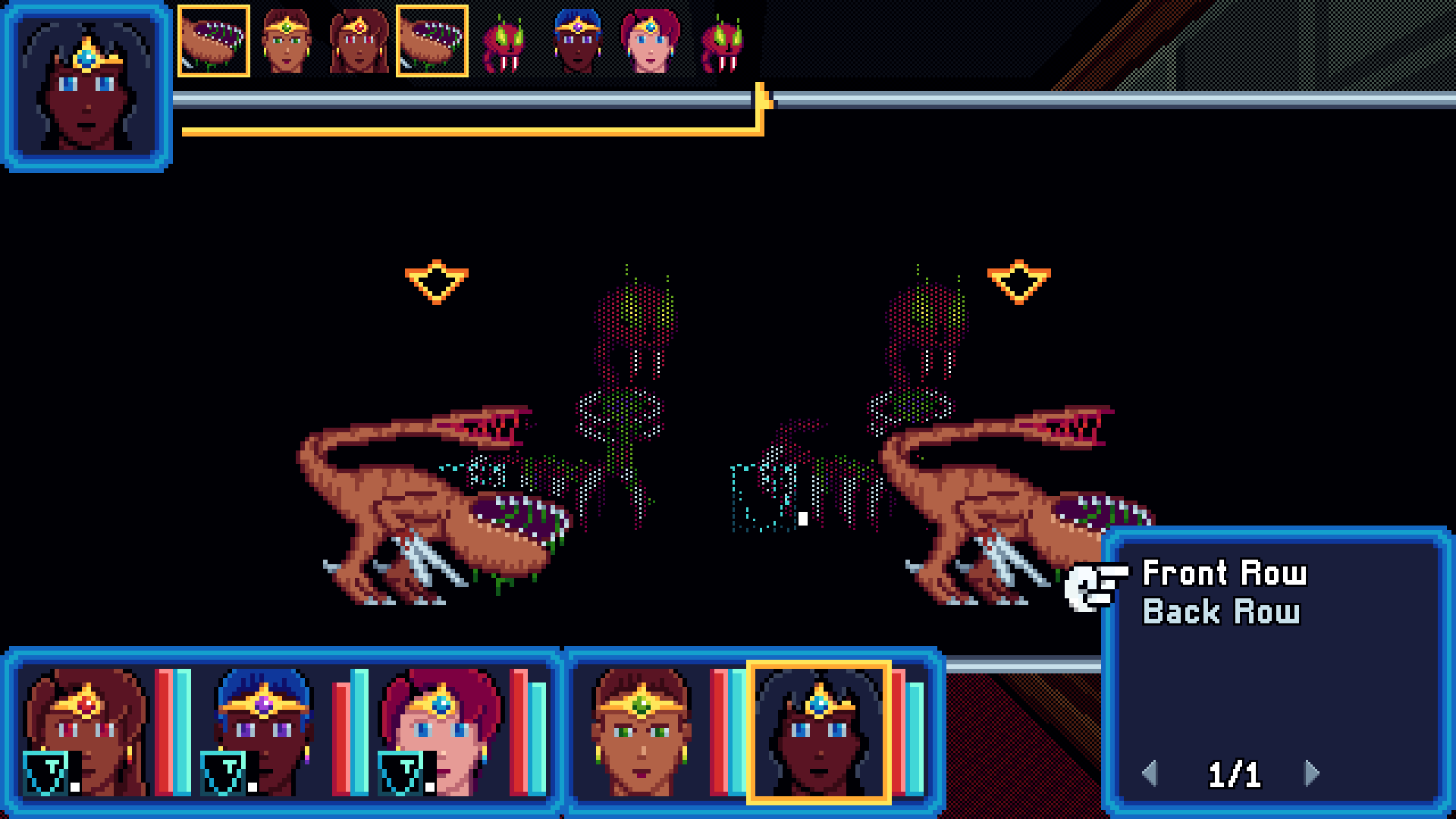
I'm not an expert, but here are two tips that helped me improve a lot:
1) I see the sprite that you linked is black and white, but when you want to try color, continue working with a limited palette (maybe 16-64 colors). This is much easier than trying to pick from several million colors. Actually creating a palette also takes experience, though, so either start VERY small (like 4 colors), or find an existing palette that appeals to you, like EGA or something from https://lospec.com/palette-list.
2) Study pixel art that you like. Zoom in, examine pixel by pixel, look at proportions and angles and colors and outlines, figure out the techniques that make it look the way it does. Then try to reproduce those effects in your own art. Even a single pixel can make a big difference in how the image turns out, so studying their placements and patterns can help you understand how to get the results you want.
The mouse cursor can't leave the game window when set in fullscreen mode, which is what I meant by "hijacking". I know this is not entirely uncommon, though I had a controller plugged in and for some reason expected that to take priority, allowing the mouse to interact with the OS or other applications.
I can't reproduce this. Can you provide more details about your setup?
I did see that status icons were displayed, I just wasn't sure how to easily identify what certain states did (especially the ones added by monster attacks). It's possible there was something I missed in the game guide or an NPC dialog.
The main menu during combat has a Status command. This will allow you to select any combatant and view details for all of their active status effects.
there are some points where I felt like there was a major disconnect between how our protagonists are framed, versus how they actually functioned in combat.
Can you give examples?
I don't think there's a problem necessarily with the support skills being less "gimmick" driven compared to melee and direct damage abilities. Though support skills often get used less when healing is a frequent need, and MP reserves are very limited. So it may be worth revisiting costs for some of the peripheral stuff, before increasing / tuning their effects.
I meant the passive skills that you choose during character creation. You said that some of these lack synergy, and I agree. I like this setup, but the choices could be more impactful or interesting.
Thank you for the detailed feedback, and I'm sorry you didn't find it engaging enough to continue. A few responses:
- The issue with screenshotting/recording exclusive fullscreen is a Windows issue; I'm not sure why exactly, but I've looked into it before and have seen it occur with many applications, including AAA games. There is however an engine issue at play here, which is that Godot for some reason automatically makes an application running at full native resolution exclusive, not windowed. The workaround to achieve windowed fullscreen is to set the window at 1px smaller - but the problem with that is that on a 16:9 display, this drops integer scaling down to the next lowest level, causing the effectively fullscreen application to run letterboxed and possibly show a pixel of desktop at the bottom. This is maybe less of a concern than it was originally, since I now have integer scaling turned off by default. I can look into adding a windowed option. I've found that pointing OBS to the display device rather than the application allows it to record properly, which is how I captured my own footage.
- I am not sure what you mean by hijacking mouse functionality.
- The lack of things like distinct field icons and attack animations is not homage, but compromise. This is simply due to the limits on my time and artistic skill, though I also view attack animations in general with skepticism because they can easily make combat drag. I can't draw and animate everything that I would like to, let alone draw them well and position them convincingly and visibly (consider a lever or magic mouth on a wall, for instance), so I have focused on what I can get the most mileage out of and leaned on flavor text to help fill in the imagination gaps. This frankly doesn't bother me as a player (even Experience does this), but I recognize that it won't be to everyone's taste.
- The status option in combat shows active effects for all combatants.
- Defense is primarily evasion, but in practice can also reduce damage taken from hits, as crit damage is based on the margin of success of the attack roll. Armor is a straight subtraction from all damage. The help screen gives a rundown of what all the stats do.
- What you say about the slow leveling, tight economy, and high damage from enemies is all intentional, and difficulty tends to be highest when first entering a new dungeon, including the hospital. Sometimes a character does get dogpiled, and I don't really intend to code anything to prevent that. If you get trashed in a bad combat, reloading is entirely legitimate.
- Your party build sounds solid. Aspects have minimum stats, but don't otherwise directly influence them; it sounds like you gave War a 12+ Vigor and a greatsword, which will give them a fairly hardy basic attack. This is true regardless of aspect, though some are harder to raise to 12 Vigor than others (I'm considering loosening the minimum stats). Base stats never increase (AD&D style), but certain substats grow at a rate derived from the base stats. For example, Power increases every level, and the higher your Vigor, the faster it increases. Defense and Accuracy increase at a constant rate. Going from level 2 to level 3 does make a significant difference in the hospital, and fully exploring the first map should almost certainly level everyone up to 3. Character creation states that base stats cannot be changed later, but I didn't make it explicit that they are wholly static, so I can clarify that.
- M. Attack is meant to be weak; originally staves and wands could not attack from the back row at all, and this was added to give those characters an alternative to just defending when not spending MP, which I think "feels" better. Magic weapons aren't make-or-break for skills, though, so a whip or (for a stronger character) bow is also an option for the back row.
- The equipment weight rules are definitely not perfect; this evolved as a kind of compromise to partition equipment in some way without having hard stat or aspect requirements. You're generally meant to keep weight at zero, though the penalties for not doing so might be too high. I'm open to suggestions. There are a couple of unique accessories in the game that reduce weight.
- I did try to give each of the three NPCs their own personality and voice, so I am sorry that that didn't come through. I'll take another look at their dialogue.
- There is an option to flip the targeting controls.
- Support skills are admittedly not as compelling as I'd like. I'm again open to suggestions here.
I forgot to mention that when I launch the game, I get this error very briefly. It disappears immediately when the game finishes launching and doesn't seem to cause a problem, but I don't know what it means or if it's a problem on my end.
(EDIT: I've been told that this is just a thing that RPG Maker does.)

I forgot to mention a couple of strange technical issues I had that I haven't seen with RPG Maker before.
First, I was playing with a gamepad, but my mouse cursor wouldn't leave the screen. Even if I moved it to my other monitors, a ghost cursor would still stay stuck in the game window. I just pushed it as far over to one side as possible.
I also saw a weird corruption/warping effect flicker a couple of times. It's hard to describe, but it was very brief and random, so I could not get a screenshot. It happened once in the eastern forest, the other I don't recall where (maybe the same area).
There is one other thing too, which I also saw with another game in FBQ8. When launching the game, I get the below error popup for a split second. It goes away when the game finishes launching and doesn't seem to cause any problems, but I have no idea what it means.

Oh, is it called Battle_Tower_Royale_3_17_2024? No wonder I couldn't find it. Incidentally, multiple save slots would also be good to have.
I see what you mean now. Yes, this is very confusing. I thought I was choosing a starting feat there, not just reviewing them, but what makes it more confusing is that if you select +1 regeneration for the racial bonus, this DOES start you with one rank in the Regeneration feat, whereas choosing +1 attack or +10 health does not translate to a feat. This is why I misremembered and thought I had chosen it as a feat.
Thanks for the reply. A couple more thoughts:
The rank/position of Captain is currently vacant, and was being primed for Oswyn. It was really just a matter of him wanting to accept the rank and proceed with the formalities to make it official.
OK, I see. This could use a little more clarity.
As for the reason for letting Angus go, I thought it was pretty clear that Angus used his leverage to reveal who had the Dagger stolen. He did give Angus his word that he'd let him go, and so my goal was to also use that decision to convey to the player that Oswyn tries to be an honorable man despite being somewhat conflicted at times.
I understood the conversation, yeah. I mentioned it because regardless of his reasoning, it's a very rogue (maybe unlawful, even) action that he commits to with little hesitation and which seems unlikely to play well with the emperor, who is absolutely furious over the theft. It's not really what I would expect from a committed soldier and future captain, but if that is your intended takeaway, that's fine. Along with our other data points, we can draw some conclusions from it.
I'm trying to put my finger on what's tripping me up here. I think maybe I wasn't sure if I was meant to read him as conflicted or not, or in what scope. His comments at the cemetery have more of an uncomfortable "warrior in peacetime" tone.
I'm making this sound like way more of a big deal than it actually is. Sorry.
With regards to his association with Oswyn, Emperor Junon does say to Bayard during the meeting in the throne room: "Bayard, I assume you have no qualms about working with an old friend?" I'm not sure if that's enough to drive the point home. But I figured that, along with how candid Bayard and Oswyn are with one another, would be enough to convey to the player that they grew up together. Again, the scene can probably use some work to be more to be either explicit or even implicit in more ways.
That specific line can also be taken as court sarcasm, which was actually my first instinct as I didn't recall his name from the cemetery; they could be hated enemies and the entire exchange could be written the exact same way (though their discussion outside the chamber dispels that consideration). I think concluding that they grew up together is a bit of a jump (I didn't get that), but I did gather from everything given that they were at least friends or former colleagues, if sometimes a bit contentious with each other.
Feats are obtained by spending Feat Points - so you didn't miss out on that 40-point Feat, you'd just be able to spend the few points you started with on an equally small Feat.
My concern is that when you boil this down, the starting feat choice is essentially "Would you rather start with 40 points or 1 point?" Phrased like that, why would I want to pick 1 point?
I don't want to unfairly put too fine a point on it based on such a small piece of the game (and honestly you can pick any story apart if you think about it long enough), so don't worry about it too much. You are probably right that a little polishing would probably clear things up a lot. It might just be a reading comprehension issue on my part.
I guess I wasn't really sure who Oswyn is as a character? We can see that in the introduction he's gung-ho for the empire, and after the time skip, he seems to have settled into the soldier routine. Beyond that though, I felt like I didn't quite get to know him during the time I was playing as him; his interactions with other characters are mostly in the context of just doing his job. So from that, we might say that he takes his profession seriously - but he also blows off an important ceremony and readily lets Angus go, which don't really square with that, though he does mention finding his duties unfulfilling.
I actually felt like I learned more about him from Ysabel's characterization: she is clearly written as the more fiery and chaotic of the two (this was foreshadowed well in the prologue), which sets her up as a foil to highlight Oswyn's more reserved behavior. Is this how you intended it? I'm not sure if Ysabel is a consistent party member or just someone who drops in from time to time; if it's the former, I'm sure this dynamic will develop a lot more after the demo, since here it is just getting started.
Something I was a little confused about: his rank is Lieutenant, but at the cemetery he talks about becoming Captain - it's not clear here whether he has actually attained that, or is still aiming for it, though it kind of implies the former. Is Captain here a formal military rank, or more of a specific post and responsibility that is detached from actual rank? He's the only ranking soldier present at the council meeting, which implies that he's in a top-level leadership position, but it seems odd to me that that position would be held by a lieutenant (I am not an expert in military hierarchy, sorry).
As for Bayard, it was kind of weird having him in the party without really knowing what his deal is. I went back and replayed the introduction to remind myself of exactly what was said. We know that he apparently has a seat at the council meeting as a representative of a guild - I assume that this was referring to Elynor's adventurer's guild, but I don't think that was made explicit during the demo. We also know that he is acquainted with Oswyn in some manner, at least closely enough that Elynor mentions him at the cemetery (I noticed that this was misspelled as "cemetary", btw).
I probably shouldn't pick on Elynor too much since she only gets one scene - though, she apparently had enough wealth and prestige to found the adventurer's guild, so I did wonder where that came from, since all we know is that she's an army widow. I'm a little unsure of the guild's (and by extension Elynor's) actual position; Bayard mentions that his guildmates (again, assuming that this is the guild he's talking about) probably couldn't handle a few low-level thieves, which makes me wonder what they're actually good for, but the guild is also apparently influential enough to have a seat at the imperial council, and is a large enough operation that Elynor can delegate that seat. Elynor herself is often not even in Westwind, so whether the guild has other branches that she visits or if she has some unrelated business that involves traveling frequently, we don't know just yet (this may be intentional).


